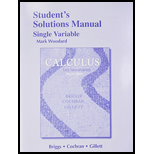
Concept explainers
Loan problems The following initial value problems model the payoff of a loan. In each case, solve the initial value problem, for t ≥ 0, graph the solution, and determine the first month in which the loan balance is zero.
26.
Trending nowThis is a popular solution!

Chapter D1 Solutions
Student Solutions Manual, Single Variable for Calculus: Early Transcendentals
Additional Math Textbook Solutions
Thinking Mathematically (6th Edition)
Basic Business Statistics, Student Value Edition
Calculus for Business, Economics, Life Sciences, and Social Sciences (14th Edition)
Calculus: Early Transcendentals (2nd Edition)
A Problem Solving Approach To Mathematics For Elementary School Teachers (13th Edition)
A First Course in Probability (10th Edition)
- (3) (4 points) Given three vectors a, b, and c, suppose: |bx c = 2 |a|=√√8 • The angle between a and b xc is 0 = 135º. . Calculate the volume a (bxc) of the parallelepiped spanned by the three vectors.arrow_forwardCalculate these limits. If the limit is ∞ or -∞, write infinity or-infinity. If the limit does not exist, write DNE: Hint: Remember the first thing you check when you are looking at a limit of a quotient is the limit value of the denominator. 1. If the denominator does not go to 0, you should be able to right down the answer immediately. 2. If the denominator goes to 0, but the numerator does not, you will have to check the sign (±) of the quotient, from both sides if the limit is not one-sided. 3. If both the numerator and the denominator go to 0, you have to do the algebraic trick of rationalizing. So, group your limits into these three forms and work with them one group at a time. (a) lim t-pi/2 sint-√ sin 2t+14cos ² t 7 2 2 2cos t (b) lim sint + sin 2t+14cos = ∞ t-pi/2 2 2cos t (c) lim cost-√sin 2t+14cos² t = t-pi/2 2cos t (d) lim t→pi/2 cost+√ sin t + 14cos 2cos ² t = ∞ (e) lim sint-v sin 2 t + 14cos = 0 t-pi/2 (f) lim t-pi/2 sin t +√ sin 2sin 2 t 2 t + 14cos t 2sin t cost- (g)…arrow_forwardThink of this sheet of paper as the plane containing the vectors a = (1,1,0) and b = (2,0,0). Sketch the parallelogram P spanned by a and b. Which diagonal of P represents the vector a--b geometrically?arrow_forward
- (1) (14 points) Let a = (-2, 10, -4) and b = (3, 1, 1). (a) (4 points) Using the dot product determine the angle between a and b. (b) (2 points) Determine the cross product vector axb. (c) (4 points) Calculate the area of the parallelogram spanned by a and b. Justify your answer. 1arrow_forward(d) (4 points) Think of this sheet of paper as the plane containing the vectors a = (1,1,0) and b = (2,0,0). Sketch the parallelogram P spanned by a and b. Which diagonal of P represents the vector ab geometrically? d be .dx adjarrow_forward(2) (4 points) Find all vectors v having length 1 that are perpendicular to both =(2,0,2) and j = (0,1,0). Show all work. a=arrow_forward
- For the following function, find the full power series centered at a of convergence. 0 and then give the first 5 nonzero terms of the power series and the open interval = f(2) Σ 8 1(x)--(-1)*(3)* n=0 ₤(x) = + + + ++... The open interval of convergence is: 1 1 3 f(x)= = 28 3x6 +1 (Give your answer in help (intervals) .)arrow_forwardFor the following function, find the full power series centered at x = 0 and then give the first 5 nonzero terms of the power series and the open interval of convergence. f(x) = Σ| n=0 9 f(x) = 6 + 4x f(x)− + + + ++··· The open interval of convergence is: ☐ (Give your answer in help (intervals) .)arrow_forwardLet X be a random variable with the standard normal distribution, i.e.,X has the probability density functionfX(x) = 1/√2π e^-(x^2/2)2 .Consider the random variablesXn = 20(3 + X6) ^1/2n e ^x^2/n+19 , x ∈ R, n ∈ N.Using the dominated convergence theorem, prove that the limit exists and find it limn→∞E(Xn)arrow_forward
- Let X be a discrete random variable taking values in {0, 1, 2, . . . }with the probability generating function G(s) = E(sX). Prove thatVar(X) = G′′(1) + G′(1) − [G′(1)]2.[5 Marks](ii) Let X be a random variable taking values in [0,∞) with proba-bility density functionfX(u) = (5/4(1 − u^4, 0 ≤ u ≤ 1,0, otherwise. Let y =x^1/2 find the probability density function of Yarrow_forward2. y 1 Ο 2 3 4 -1 Graph of f x+ The graph gives one cycle of a periodic function f in the xy-plane. Which of the following describes the behavior of f on the interval 39 x < 41 ? (Α B The function f is decreasing. The function f is increasing. The function f is decreasing, then increasing. D The function f is increasing, then decreasing.arrow_forwardDepth (feet) 5- 4- 3- 2. WW www 1 D B 0 10 20 30 40 50 60 70 80 Time (hours) x A graph of the depth of water at a pier in the ocean is given, along with five labeled points A, B, C, D, and E in the xy-plane. For the time periods near these data points, a periodic relationship between depth of water, in feet, and time, in hours, can be modeled using one cycle of the periodic relationship. Based on the graph, which of the following is true? B C The time interval between points A and B gives the period. The time interval between points A and C gives the period. The time interval between points A and D gives the period. The time interval between points A and E gives the period.arrow_forward
- Algebra & Trigonometry with Analytic GeometryAlgebraISBN:9781133382119Author:SwokowskiPublisher:Cengage
